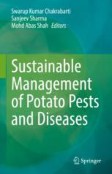Search
Search Results
-
Oral-based nanoparticle-wrapped dsRNA delivery system: a promising approach for controlling an urban pest, Blattella germanica
Chitin synthase is an indispensable enzyme that is involved in the synthesis of chitin, a key component of the insect cuticle during insect...

-
Jasmonic Acid-Treated Cotton Plant Leaves Impair Larvae Growth Performance, Activities of Detoxification Enzymes, and Insect Humoral Immunity of Cotton Bollworm
Enhancement of plant defense by exogenous elicitors is a promising tool for integrated pest management strategy. In the present study, cotton plants...

-
Biological Suppression of Insect Pests of Potato
Global and Indian agri-horti-dairy markets are transforming agriculture to smart agriculture with commodities driven by quality and safety. Natural...
-
On the enzymes’ actions of entomopathogenic fungi against certain indigenous and invasive insect pests
BackgroundPathogenicity of entomopathogenic fungi (EPF) depends mainly on their ability to produce efficient enzymes, which degrade insect’s...

-
Form and Function
The physiology and morphology of insects largely explain the immense adaptability of these organisms to forest ecosystems. This chapter presents an...
-
Microbial Biopesticides Use in Insect-Pest Management: An Overview
Insect, pathogens, weeds, and invertebrates as pests cause significant crop losses worldwide and act as a barrier in achieving the aim of global food...
-
Molecular Approaches for Insect Pest Management in Rice
This chapter focuses on the progress made in using molecular tools in understanding resistance in rice to insect pests and breeding rice for multiple...
-
Oligonucleotide insecticides and RNA-based insecticides: 16 years of experience in contact using of the next generation pest control agents
Recently, sustainable and ecological approach in plant protection has produced many innovative ideas, including insecticides based on nucleic acids....

-
Enzyme-mediated adaptation of herbivorous insects to host phytochemicals
AbstractThe review comprehensively explores factors influencing enzyme activities in insects and their implications in defense against toxicants. It...

-
Benefits of insect colours: a review from social insect studies
Insect colours assist in body protection, signalling, and physiological adaptations. Colours also convey multiple channels of information. These...

-
Unraveling the Importance of Metabolites from Entomopathogenic Fungi in Insect Pest Management
More than 750 species of entomopathogenic fungi (EPF) belonging to 85 genera are reported to date infecting more than 1000 species of insect pests....
-
Physiological and Biochemical Mechanisms of Insect Color Change Towards Understanding Molecular Links
Insect color patterns are prominently diverse, serving significant physiological and ecological functions. However, the environments surrounding...
-
Microbial Hydrolytic Enzymes: Powerful Weapons Against Insect Pests
During its history, humankind has been affected by three factors: food deficiency, health problems, and environmental issues. With world’s population...
-
Fatty acyl-CoA reductase influences wax biosynthesis in the cotton mealybug, Phenacoccus solenopsis Tinsley
Mealybugs are highly aggressive to a diversity of plants. The waxy layer covering the outermost part of the integument is an important protective...

-
Effects of Entomopathogens on Insect Predators and Parasitoids
High reliance on chemical pesticides for controlling phytophagous pests in agro-ecosystems has resulted in different negative effects, and this issue...
-
Unraveling the Coevolutionary Arms Race: Insights into the Dynamic Interplay of Plants, Insects and Associated Organisms
Insect–plant interactions are complex and dynamic relationships that have evolved over millions of years. Plants have developed various adaptations...
-
Molecular Signatures of Host–Pathogen Interactions in Virus-Infected Lepidopterans
The role of insects as a model in innate immunity research is unquestionable. Along with Drosophila, Lepidopteran larvae are among the most common...
-
Factors Affecting Growth and Metabolism of Insects
Factors that affect growth and metabolism is discussed in detail. The role of abiotic factors such as temperature, humidity, rainfall, light, and...
-
Individual and combined treatments with imidacloprid and spinosad disrupt survival, life-history traits, and nutritional physiology of Spodoptera littoralis
The Egyptian cotton leafworm Spodoptera littoralis (Boisduval) (Lepidoptera: Noctuidae) is a pervasive agricultural polyphagous insect pest. Because...

-
Mitochondria dysfunction impairs Tribolium castaneum wing development during metamorphosis
The disproportionate growth of insect appendages such as facultative growth of wings and exaggeration of beetle horns are examples of phenotypic...

